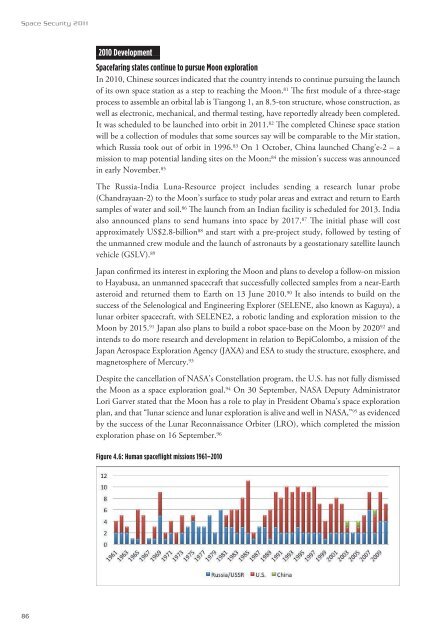Space Security Index
Space Security Index
Space Security Index
Create successful ePaper yourself
Turn your PDF publications into a flip-book with our unique Google optimized e-Paper software.
<strong>Space</strong> <strong>Security</strong> 2011<br />
86<br />
2010 Development<br />
<strong>Space</strong>faring states continue to pursue Moon exploration<br />
In 2010, Chinese sources indicated that the country intends to continue pursuing the launch<br />
of its own space station as a step to reaching the Moon. 81 e rst module of a three-stage<br />
process to assemble an orbital lab is Tiangong 1, an 8.5-ton structure, whose construction, as<br />
well as electronic, mechanical, and thermal testing, have reportedly already been completed.<br />
It was scheduled to be launched into orbit in 2011. 82 e completed Chinese space station<br />
will be a collection of modules that some sources say will be comparable to the Mir station,<br />
which Russia took out of orbit in 1996. 83 On 1 October, China launched Chang’e-2 – a<br />
mission to map potential landing sites on the Moon; 84 the mission’s success was announced<br />
in early November. 85<br />
The Russia-India Luna-Resource project includes sending a research lunar probe<br />
(Chandrayaan-2) to the Moon’s surface to study polar areas and extract and return to Earth<br />
samples of water and soil. 86 e launch from an Indian facility is scheduled for 2013. India<br />
also announced plans to send humans into space by 2017. 87 e initial phase will cost<br />
approximately US$2.8-billion 88 and start with a pre-project study, followed by testing of<br />
the unmanned crew module and the launch of astronauts by a geostationary satellite launch<br />
vehicle (GSLV). 89<br />
Japan con rmed its interest in exploring the Moon and plans to develop a follow-on mission<br />
to Hayabusa, an unmanned spacecraft that successfully collected samples from a near-Earth<br />
asteroid and returned them to Earth on 13 June 2010. 90 It also intends to build on the<br />
success of the Selenological and Engineering Explorer (SELENE, also known as Kaguya), a<br />
lunar orbiter spacecraft, with SELENE2, a robotic landing and exploration mission to the<br />
Moon by 2015. 91 Japan also plans to build a robot space-base on the Moon by 2020 92 and<br />
intends to do more research and development in relation to BepiColombo, a mission of the<br />
Japan Aerospace Exploration Agency (JAXA) and ESA to study the structure, exosphere, and<br />
magnetosphere of Mercury. 93<br />
Despite the cancellation of NASA’s Constellation program, the U.S. has not fully dismissed<br />
the Moon as a space exploration goal. 94 On 30 September, NASA Deputy Administrator<br />
Lori Garver stated that the Moon has a role to play in President Obama’s space exploration<br />
plan, and that “lunar science and lunar exploration is alive and well in NASA,” 95 as evidenced<br />
by the success of the Lunar Reconnaissance Orbiter (LRO), which completed the mission<br />
exploration phase on 16 September. 96<br />
Figure 4.6: Human spaceflight missions 1961–2010

















